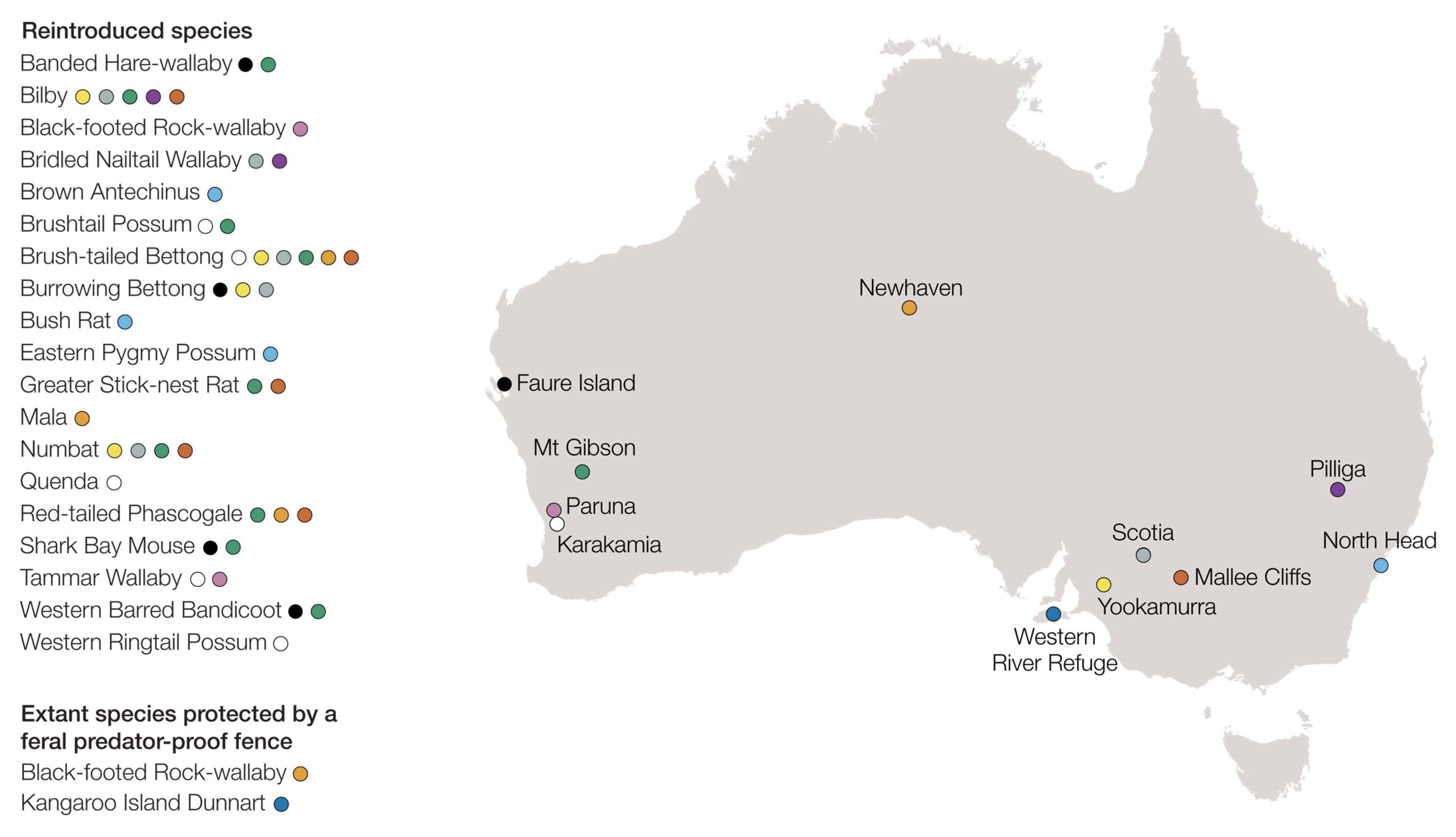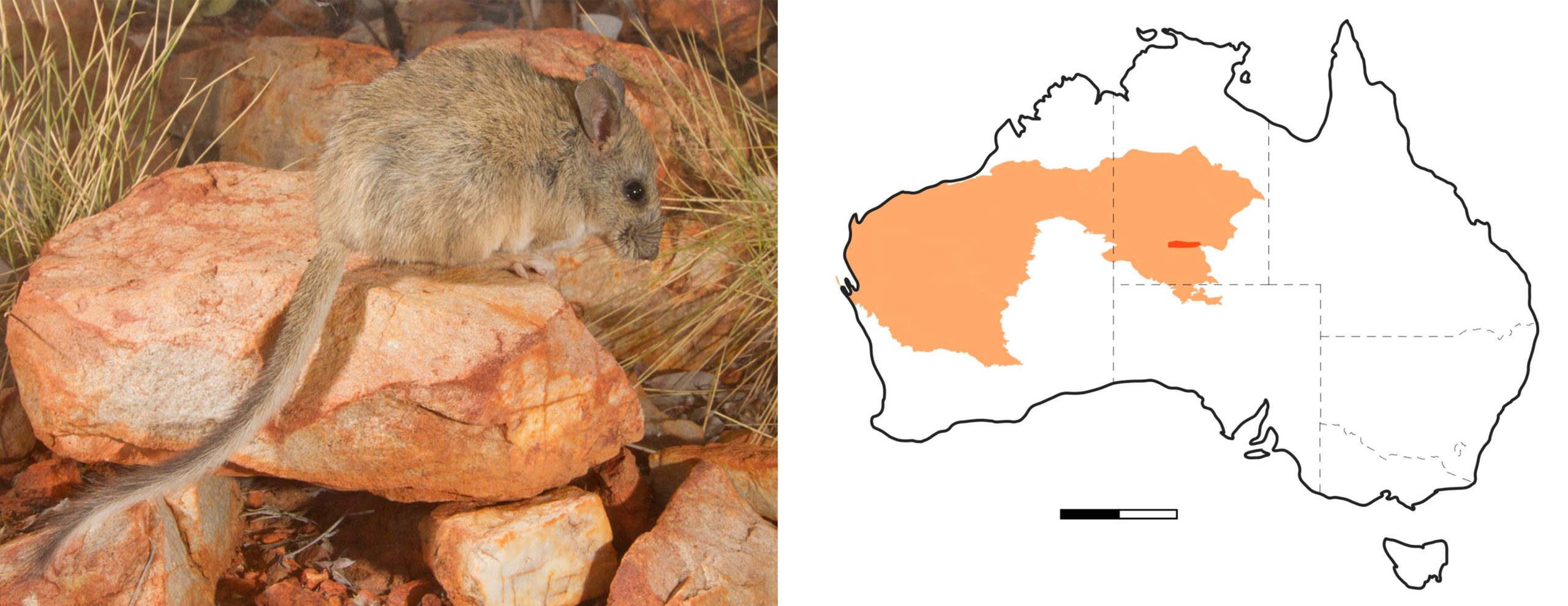By Dr Jennifer Anson, Senior Ecologist
The global loss of wildlife has led many to suggest the earth is currently experiencing a sixth mass extinction event. Australia is no exception, with the impacts of feral cats and foxes, habitat loss and fragmentation, changed fire regimes and feral herbivores resulting in the world’s worst mammal extinction rate. Thirty-three mammal species have become extinct in Australia since European colonisation and another 60 of the remaining species are highly or extremely susceptible to feral predators.
Australian Wildlife Conservancy’s (AWC) reintroduction program is a proactive way to address the current conservation crisis facing threatened mammals. AWC has established feral predator-free exclosures at nine diverse locations across southern and central Australia to provide safe havens for species that have long been extirpated from these areas. For example, Faure Island, part of the Shark Bay World Heritage Area off the coast of Western Australia, has been completely free of feral predators and herbivores for 20 years. This has allowed reintroduced populations of Boodies (Burrowing Bettongs), Banded Hare-wallabies, Western Barred Bandicoots and Shark Bay Mice to thrive across the 5,200-hectare island, as well as helping the conservation of extant populations of 36 reptile and 127 bird species.

Reintroductions contribute to the conservation of species and ecosystems by:
AWC’s reintroduction program has expanded dramatically since the first reintroductions to Karakamia Wildlife Sanctuary in 1994, to encompass 19 species, 9 feral predator-free areas and 2 feral predator-managed areas at the time of writing (additional species and another site are planned to be added in 2022). Our expertise in this space have meant we have been able to provide advice to several state governments and a number of private organisations. AWC aims to play a leading role in the national effort by the conservation sector to restore threatened mammals to parts of their former ranges, consistent with key actions in the Federal Government’s Threatened Species Strategy Action Plan. AWC’s work is significant to the plan: 6 of the 20 priority mammal species are part of AWC’s reintroduction program and 10 are already protected on AWC sanctuaries and partnership areas. In 2022, AWC will be further developing its national reintroduction strategy to guide the extensive work being undertaken to re-establish populations of some of Australia’s most threatened and iconic fauna.
 Jane Palmer
Jane Palmer
A good example of the success of AWC’s reintroduction program is the Woylie (Brush-tailed Bettong). This species was the first to be reintroduced to AWC’s first wildlife sanctuary – Karakamia. From 2015–18, AWC translocated over 160 Woylies from Karakamia and other founding populations to the 7,840-hectare feral predator-free area at Mt Gibson Wildlife Sanctuary in Western Australia. Since then, the genetically diverse population has expanded to over 1,800 individuals. In turn, Mt Gibson has now been used to establish new populations at Newhaven Wildlife Sanctuary in the Northern Territory and Mallee Cliffs National Park in south-western NSW. Plans are underway to translocate Woylies from Mt Gibson to two other locations in NSW in 2022.
AWC is embarking on some exciting new challenges in 2022. We have been working closely with the Northern Territory Government on a plan to establish a secure population of the critically endangered Central Rock-rat outside of its highly restricted remnant distribution. The species has suffered a 95% reduction in its range: once reported from scattered locations across much of the southern Northern Territory and (in the subfossil record) a large portion of arid Western Australia, it is now restricted to a few hundred hectares on mountain tops west of Alice Springs. If AWC can successfully establish a population within the 9,400-hectare feral predator-free area at Newhaven Wildlife Sanctuary, it will be a huge conservation gain for the species. Newhaven will also welcome Greater Bilbies back in 2022, restoring to the landscape a species of deep cultural significance, as well as of enormous ecological and conservation benefit.

Securing additional populations is crucial to many of Australia’s unique mammals. The pervasive threat of feral predators will result in the continued loss of populations and species. In the existing program and over the coming years, AWC plans to secure the long-term protection of more than 25 threatened and locally extinct mammal species. The Northern Bettong, recognised as one of 20 Australian mammals most at risk of extinction, is one of these species. This endangered Potoroidae has an estimated global population size of less than 1,200 individuals. As a keystone species, responsible for the dispersal of a broad range of ectomycorrhizal fungi, they play an essential role in forest health. AWC scientists have been working closely with Queensland Parks and Wildlife Service and the Western Yalanji Aboriginal Corporation to monitor one of only two remaining populations and manage threats that are driving rapid declines in the area. In Far North Queensland AWC is constructing a feral predator-proof fence at Mount Zero– Taravale Wildlife Sanctuary, to conserve key habitat. This will provide critical protection to a new population to be established within the safe haven.
In recognition of AWC’s leading role in the reintroduction of threatened mammals in Australia, AWC have been invited to participate in the first Global Meeting of Conservation Translocation Practitioners, to be held in Spain in 2022. Eight ‘maestros’ from different continents and conservation cultures will present in-depth overviews of their organisation’s reintroduction programs. The meeting aims to promote the exchange of practical knowledge and build a global network of rewilding practitioners. AWC will be represented at the meeting by Chief Science Officer, Dr John Kanowski, who has overseen AWC’s reintroduction program for most of the last decade.
 David Sickerdick/AWC
David Sickerdick/AWC
Read and download the full issue of Wildlife Matters here.
Donate to help save Australia’s threatened wildlife and wild places
Donate Now